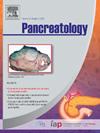Genome-wide discovery of enhancer – promoter interactions in the human pancreas using an improved Activity-By-Contact-based model
IF 2.7
2区 医学
Q2 GASTROENTEROLOGY & HEPATOLOGY
引用次数: 0
Abstract
Background/Objectives
Enhancers are key drivers of tissue-specific gene expression and can contain variants associated with pancreatic diseases. Enhancer-target gene assignment remains challenging, with the Activity-By-Contact (ABC) model, integrating open-chromatin, histone modification and chromatin interaction data, consistently outperforming other approaches. Recently an advanced version, the generalized ABC (gABC) model was published, yet lacking a clear and unique promoter definition impairing interpretability. In pancreas the model has not yet been evaluated.
Methods
We applied both basal ABC and gABC to map gene-regulatory regions to their respective candidate target genes in pancreas datasets. Next, to balance high gABC performance and ABC interpretability, we implemented the novel canonical-transcript-based and adapted ABC (caABC) model using ENSEMBL canonical transcripts. We compared the performance of all three approaches to predict gene-regulatory regions overlapping with fine-mapped pancreatic expression quantitative trait loci (eQTLs) from GTEx (V8). At the eQTL-colocalized and fine-mapped chronic pancreatitis risk locus CTRC we exemplarily evaluated predicted enhancer-promoter interactions. Finally, we provide a genome-wide unified caABC dataset of pancreatic enhancers and regulated genes.
Results
We demonstrate significantly improved performance of both gABC and caABC compared to ABC in the pancreas, with slightly better performance of gABC at the cost of impaired interpretability compared to caABC. At the chronic pancreatitis risk locus CTRC, caABC enhancer predictions separate fine-mapped risk-variants from high-LD non-fine-mapped variants.
Conclusions
We provide a genome-wide set of pancreas-specific enhancer regions and respective target genes. Our dataset will be helpful for the prioritization of regulatory disease-causing mutations in pancreatic tissue.
使用改进的基于接触的活性模型在人类胰腺中发现增强子-启动子相互作用的全基因组发现。
背景/目的:增强子是组织特异性基因表达的关键驱动因素,可能包含与胰腺疾病相关的变异。增强子-靶基因分配仍然具有挑战性,而结合开放染色质、组蛋白修饰和染色质相互作用数据的接触活性(ABC)模型一直优于其他方法。最近,一个高级版本的广义ABC (gABC)模型被发表,但缺乏一个清晰和独特的启动子定义,从而影响了可解释性。胰腺模型尚未被评估。方法:我们应用基础ABC和gABC将基因调控区域定位到胰腺数据集中各自的候选靶基因。接下来,为了平衡高gABC性能和ABC可解释性,我们使用ENSEMBL标准转录本实现了新的基于标准转录本的改编ABC (caABC)模型。我们比较了所有三种方法在预测基因调控区域与GTEx (V8)精细定位的胰腺表达数量性状位点(eQTLs)重叠方面的性能。在eqtl共定位和精细定位的慢性胰腺炎风险位点CTRC上,我们举例评估了预测的增强子-启动子相互作用。最后,我们提供了胰腺增强子和调节基因的全基因组统一caABC数据集。结果:我们证明,与胰腺中的ABC相比,gABC和caABC的表现都有显著改善,与caABC相比,gABC的表现略好,但代价是可解释性受损。在慢性胰腺炎风险位点CTRC, caABC增强子预测将精细映射的风险变异与高ld非精细映射的变异分开。结论:我们提供了一套全基因组的胰腺特异性增强子区域和各自的靶基因。我们的数据集将有助于胰腺组织中调节性致病突变的优先排序。
本文章由计算机程序翻译,如有差异,请以英文原文为准。
求助全文
约1分钟内获得全文
求助全文
来源期刊

Pancreatology
医学-胃肠肝病学
CiteScore
7.20
自引率
5.60%
发文量
194
审稿时长
44 days
期刊介绍:
Pancreatology is the official journal of the International Association of Pancreatology (IAP), the European Pancreatic Club (EPC) and several national societies and study groups around the world. Dedicated to the understanding and treatment of exocrine as well as endocrine pancreatic disease, this multidisciplinary periodical publishes original basic, translational and clinical pancreatic research from a range of fields including gastroenterology, oncology, surgery, pharmacology, cellular and molecular biology as well as endocrinology, immunology and epidemiology. Readers can expect to gain new insights into pancreatic physiology and into the pathogenesis, diagnosis, therapeutic approaches and prognosis of pancreatic diseases. The journal features original articles, case reports, consensus guidelines and topical, cutting edge reviews, thus representing a source of valuable, novel information for clinical and basic researchers alike.
 求助内容:
求助内容: 应助结果提醒方式:
应助结果提醒方式:


